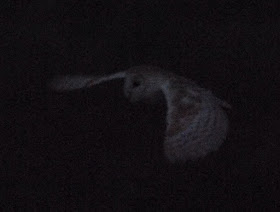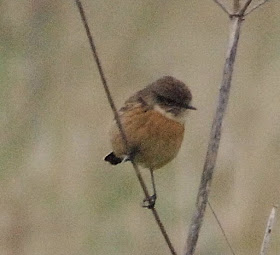Setting off at 5a.m. meant, having stopped for coffee near Downham Market, I was in Titchwell carpark way before 1st light, as planned. My idea was to be on the beach for sunrise and spot as many birds on the Freshmarsh in the pre dawn grey light as possible. With only a few hours of decent light, I wanted to get the year list off to a good start by paying visits to all the Norfolk Coastal hotspots.
I was greeted with both song thrush and mistle thrush singing, before I checked the feeders, but too early. This photo of the regular barn owl is testimony to the light levels!
I scanned the freshmarsh, picking out many of the usual suspects: godwits, avocets, brents, teal, shoveler, lapwings etc before arriving at the beach just as the colour was changing, promising a bright day.
 |
| Barn owl, out of the darkenss of Thornham Marsh |
 |
| Hint of colour on the beach |
 |
| Early morning brents at low tide |
 |
| Another shot of the ghost owl |
From the beach the waders at the low tide mark were easily visible as the light improved rapidly: grey plover, sanderling, turnstone, dunlin, bar tailed and black tailed godwit along with gulls and geese. 2 mute swans headed west but only a few goldeneye, 7 common scoter and 2 red throated divers were noted on the sea.
 |
| Sunrise over the wet sand: Titchwell |
 |
| Early morning brent geese flypast |
 |
| Black tailed godwit in early morning light |
 |
| same bird |
A few poor light shots were taken at ISO 2000 but not many worth bothering with. A quick scan from the Parrinder Hide and then a check on Thornham Pool. The latter gave views of 2 water pipits with 5 meadow pipits before I checked the feeders again, a chiffchaff on the path to the car park and I was heading off to Choseley.
 |
| Greylag from Parrinder Hide |
 |
| Better light for this drake teal |
Here, red legged partridge, yellowhammers, greenfinches, chaffinches and goldfinches along with skylarks, pied wagtails and 2 corn buntings. Then, off to Chalk Pit Lane but no views of the hoped for rough legged buzzard, just more black headed and herring gulls and a large 35+ covey of more red legged partridges.
I stopped off at Brancaster Staithe but the tide was so low that no self respecting red necked grebe would be fishing in the few inches of water, so, after a scan at Burnham Overy Staithe and Lady Anne's Drive, I arrived at Wells. Here, a solitary little grebe made the list but good to see brent geese and lapwings on the football pitch.
I decided that a walk down Garden Drove would be far too muddy, likewise a wander to the Gibbert Roundabout at Stiffkey, so off to Cley beach, where the sea was very quiet. I then headed to the VC where very little had been reported so I carried on to Salthouse beach. Upon parking, I noted a large, light brown streaky gull with light primaries. Thought it maybe one of the Iceland gulls that have been around the area recently, but on closer inspection, no, a 2nd year glaucous gull. Back to the car for the camera just in time to see it fly off to the beach, where it then departed over Gramborough Hill with 2 great black backed gulls. It looked to go down in a field near Kelling Water Meadows.
I then began scanning all the gulls, coming across an interesting individual, very pale with large bill and dark eye. It wasn't until it flew that I noted a 2nd year great black backed gull, almost black mantle just emerging.
 |
| 2nd year great black backed gull |
 |
| Very dark markings |
 |
| Wing pattern |
Having checked all other gulls, I had seen a huge flock of 5000+ geese in fields near Kelling, so off to a layby where I could scan the whole lot. After half an hour, under darkening skies, I came across the target: 6 tundra bean geese. One that didn't make my year list last year, so pleased to find them. In an adjacent field, some 1000 brent geese before I headed off to Cliff Road car park at Sheringham and a quick march down the steps to check the purple sandpipers by the Funky Mackerel cafe. Sure enough, both were present, along with the very confiding 25 turnstone flock that appear to be fed seed every day.
 |
| Pink foots in beet field |
 |
| Geese as far as you can see: Find the tundra beans!! |
 |
| Turnstone; Sheringham |
 |
| Purple sandpiper: Sheringham |
I just had time for a quick trip to West Runton cliffs for a final sea watch where 2 guillemot and 3 gannets made the day list. As I made my way back to the car the first heavy drops of rain fell and so I headed off along the A148 to Fakenham and then home. A good day, with 86 species making the day list.
 |
| More of the purple sandpiper |
Species List:
red throated diver, little grebe, gannet, cormorant, little egret, grey heron, mute swan, tudra bean goose, pink footed goose, greylag goose (10 sp) canada goose, brent goose, shelduck, mallard, gadwall, shoveler, wigeon, teal, common scoter, goldeneye (20 sp) marsh harrier, common buzzard, kestrel, red legged partridge, grey partridge, pheasant, moorhen, oystercatcher, avocet, grey plover (30 sp) golden plover, lapwing, sanderling, purple sandpiper, turnstone, dunlin, redshank, black tailed godwit, bar tailed godwit, curlew (40 sp) ruff, black headed gull, herring gull, common gull, lesser black backed gull, great black backed gull, glaucous gull, guillemot, wood pigeon, stock dove (50 sp) collared dove, tawny owl, barn owl, kingfisher, skylark, water pipit, meadow pipit, pied wagtail, wren, dunnock (60 sp) robin, stonechat, redwing, fieldfare, song thrush, mistle thrush, blackbird, chiffchaff, cetti's warbler, great tit (70 sp) blue tit, marsh tit, coal tit, magpie, jackdaw, rook, carrion crow, starling, house sparrow, chaffinch (80 sp) linnet, greenfinch, goldfinch, reed bunting, yellowhammer, corn bunting.
A good day list to kick off the New Year.



























